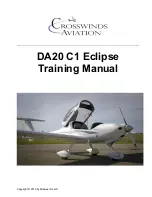
1-19
Throttle Control
30.
The Throttle Control is black and actuates the throttle valve in the FACU. In the forward /
full in position the Throttle Control is fully open (full throttle), and in the aft / full out position the
Throttle Control is fully closed (idle). The throttle control incorporates a pilot adjustable friction
lock to prevent unintended movement of the control. Rotating the lock clockwise increases
tension and vice versa.
Propeller Control
31.
The Propeller Control is blue. It is used to set and control engine RPM. When the control
is pulled out, propeller blade angles become more COARSE, and RPM is reduced; when the
control is pushed in, propeller blade angles become more FINE, and RPM is increased.
32.
The Propeller Control incorporates a vernier control feature which provides fine
adjustments. Rotate the control clockwise to increase RPM and vice versa. Rapid or large
adjustments can be made by depressing the button on the end of the control knob and
reposition control as required.
33.
Key aspects of propeller operation and control are summarized below:
a.
propeller RPM is regulated by speed sensing device (governor) which senses
RPM changes and adjusts blade angle to maintain the RPM selected by the pilot.
Maximum and minimum blade angles are established using mechanical stops;
b.
the governor uses an internal oil pump driven by the engine. This pump increases
engine oil pressure for supply to the propeller as a control medium;
c.
propeller blade angle change is accomplished via a hydraulic piston / cylinder
mounted on the forward end of the propeller hub. One end of the cylinder holds a
sealed air charge, the other side reacts to changes in oil pressure;
d.
a transient (un-commanded) increase in RPM sensed by the governor will result
in an increase in oil pressure to cause extension of the hydraulic piston. The
linear motion of the piston is transmitted to each blade by a pitch change rod,
which increases the blade angle against a mechanical return spring until hydraulic
forces, spring tension, and inertial forces establish equilibrium. The system thus
increases blade angle by an appropriate amount, increasing propeller torque to
counter the transient increase in propeller speed, thus maintaining a constant
RPM;
e.
a transient (un-commanded) decrease in RPM sensed by the governor results in
a reduction in hydraulic pressure, which causes the blade angle to be reduced by
tension in the mechanical return spring until the hydraulic forces, spring tension,
and inertial forces re-establish equilibrium. The system thus decreases blade
angle by an appropriate amount, decreasing propeller torque to counter the
transient decrease in propeller speed, thus maintaining a constant RPM;
Содержание 182
Страница 2: ......
Страница 57: ...1 39 Figure 1 47 Electrical Schematic ...
Страница 76: ...1 58 This page intentionally left blank ...
Страница 124: ...2 48 This page intentionally left blank ...
Страница 140: ...3 16 This page intentionally left blank ...















































